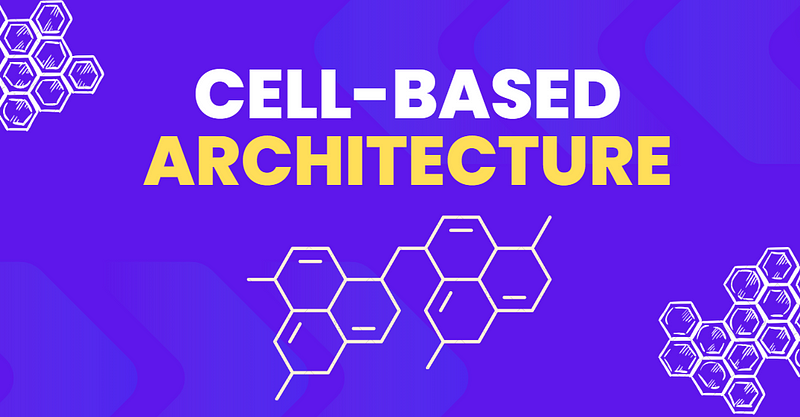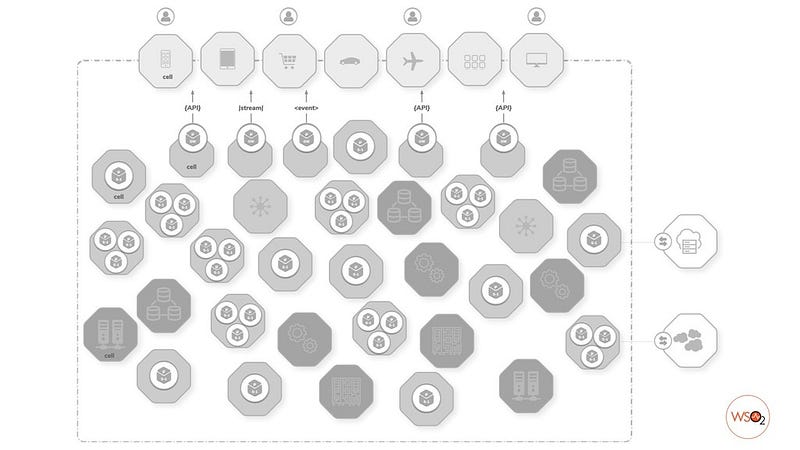Cell-based Architecture
The Cell-Based Architecture breaks down a system into numerous small, self-contained units or ‘cells’, each responsible for a specific…

The Cell-Based Architecture breaks down a system into numerous small, self-contained units or ‘cells’, each responsible for a specific function or set of functions. It takes the well-known microservices architecture a step further.
Let’s dive into it!
Key Concepts and Components of the Cell-Based Architecture

Cell Composition and Design
A ‘cell’ in this context is a discrete component that encapsulates a particular functionality. This could range from simple, singular functions to more complex sets of operations. Each cell is an independent entity, with its own input, processing logic, and output mechanisms. The design of a cell is critical; it must be robust, with well-defined interfaces for interacting with other cells or external systems.
Interface Definition and Communication Protocols
The interfaces between cells are crucial. They define how cells interact with each other and with external entities. These interfaces must be carefully designed to ensure that they are both flexible and consistent, allowing for seamless communication while avoiding tight coupling. Communication protocols between cells should be standardized, ensuring interoperability and facilitating easier integration or replacement of cells.
Data Consistency and State Management
In a cell-based architecture, maintaining data consistency and managing the state across cells is a significant challenge. Techniques such as distributed transactions, event sourcing, or eventual consistency models may be employed. The choice of technique depends on the specific requirements of the system, such as latency, throughput, and consistency needs.
Scalability and Load Balancing
One of the primary advantages of cell-based architecture is its inherent scalability. Cells can be replicated or distributed across different servers or clusters to handle increased load. Load balancing mechanisms are essential to distribute requests efficiently across these cells. This might involve dynamic routing, cluster management, and auto-scaling strategies.
Fault Tolerance and Reliability
Each cell operates independently, which enhances the system’s fault tolerance. If one cell fails, it doesn’t necessarily compromise the entire system. Implementing strategies like circuit breakers, fallback mechanisms, and redundant deployments are common practices to improve reliability. Monitoring and health checks are also vital to detect and address failures promptly.
Cell-Based Architecture vs Microservices Architecture
Fundamental Principles
Microservices Architecture:
This architecture breaks down a software application into smaller, independently deployable services, each running its process and often managing its database. These services communicate over a network, typically using HTTP/REST with JSON or XML payloads.
Cell-Based Architecture:
This architecture takes modularity a step further. It comprises even finer-grained components than microservices, called “cells.” These cells are self-contained units with their functionality, data, and communication mechanisms. They are designed to function independently but can interact with other cells to form a larger, cohesive system.
Advantages
Microservices:
- Independence: Allows for the independent development, deployment, and scaling of individual services.
- Technological Diversity: Teams can choose different technologies for different services.
- Resilience: Service independence increases the overall system’s resilience.
Cell-Based:
- Fine-Grained Scalability: Offers more precise scaling capabilities due to smaller component size.
- Enhanced Fault Isolation: The failure of one cell does not necessarily compromise the entire system.
- Optimized Resource Usage: Allows for more efficient use of resources, as each cell can be optimized individually.
Challenges
Microservices:
- Complexity in Communication: Managing communication and data consistency between services can be complex.
- Overhead: Each microservice might end up having duplicated effort in terms of handling data, communication, and security.
- Deployment Complexity: Requires sophisticated CI/CD pipelines and orchestration tools.
Cell-Based:
- Increased Complexity: The finer granularity leads to a higher number of components to manage.
- Communication Overhead: More intricate communication patterns are needed to ensure cells work together effectively.
- Design Challenges: Requires careful design to avoid too much interdependence among cells.
Best Fit Scenarios
Microservices Architecture Best Fits:
- Large-Scale Enterprise Applications: Where different teams can handle different services, allowing for parallel development and deployment.
- Applications Requiring Scalability and Flexibility: Suitable for businesses that need to quickly adapt to changing market demands.
- Legacy System Modernization: Ideal for transitioning from a monolithic architecture to a more modular approach.
Cell-Based Architecture Best Fits:
- Highly Dynamic and Scalable Systems: Such as cloud-native applications, where demand can fluctuate dramatically.
- Edge Computing and IoT Applications: Where small, independent functions need to operate reliably with minimal resources.
- Systems with Complex Business Logic: That require a high degree of modularity and isolation for individual components.
Integration with Contemporary Technologies
Both architectures integrate well with contemporary technologies like containerization and orchestration tools. Microservices often leverage these technologies for deployment and scalability, while cell-based architecture uses them to manage the increased complexity and inter-cell communications.
Development and Maintenance Considerations
Microservices:
- Development is often simpler compared to cell-based architecture due to less granular components.
- Maintenance can be challenging due to the need to manage multiple services and their interactions.
Cell-Based:
- Development requires a deep understanding of the system’s modularity to effectively design each cell.
- Maintenance involves managing a larger number of smaller components, which can be both a challenge and an advantage in terms of isolation and fault tolerance.
Performance and Efficiency
Both architectures aim to improve performance and efficiency, but their approaches differ. Microservices can sometimes lead to duplicated effort across services, whereas cell-based architecture, with its finer granularity, can optimize resource usage more effectively.
Conclusion
In conclusion, both microservices and cell-based architectures offer robust frameworks for building scalable, flexible, and resilient software systems.
The choice between the two often depends on the specific requirements of the project, including scale, complexity, and available resources.
Microservices architecture is well-suited for large-scale enterprise applications that require a balance of modularity and manageability.
In contrast, cell-based architecture is ideal for systems where extreme modularity, scalability, and resource efficiency are paramount.
🚀 Explore a Wealth of Resources in Software Development and More by Luis Soares
📚 Learning Hub: Expand your knowledge in various tech domains, including Rust, Software Development, Cloud Computing, Cyber Security, Blockchain, and Linux, through my extensive resource collection:
- Hands-On Tutorials with GitHub Repos: Gain practical skills across different technologies with step-by-step tutorials, complemented by dedicated GitHub repositories. Access Tutorials
- In-Depth Guides & Articles: Deep dive into core concepts of Rust, Software Development, Cloud Computing, and more, with detailed guides and articles filled with practical examples. Read More
- E-Books Collection: Enhance your understanding of various tech fields with a series of free e-Books, including titles like “Mastering Rust Ownership” and “Application Security Guide” Download eBook
- Project Showcases: Discover a range of fully functional projects across different domains, such as an API Gateway, Blockchain Network, Cyber Security Tools, Cloud Services, and more. View Projects
- LinkedIn Newsletter: Stay ahead in the fast-evolving tech landscape with regular updates and insights on Rust, Software Development, and emerging technologies by subscribing to my newsletter on LinkedIn. Subscribe Here
🔗 Connect with Me:
- Medium: Read my articles on Medium and give claps if you find them helpful. It motivates me to keep writing and sharing Rust content. Follow on Medium
- Personal Blog: Discover more on my personal blog, a hub for all my Rust-related content. Visit Blog
- LinkedIn: Join my professional network for more insightful discussions and updates. Connect on LinkedIn
- Twitter: Follow me on Twitter for quick updates and thoughts on Rust programming. Follow on Twitter
Wanna talk? Leave a comment or drop me a message!
All the best,
Luis Soares
luis.soares@linux.com
Senior Software Engineer | Cloud Engineer | SRE | Tech Lead | Rust | Golang | Java | ML AI & Statistics | Web3 & Blockchain



